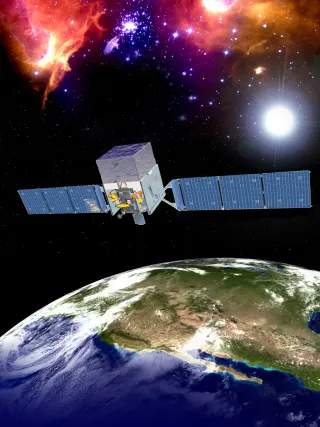Accretion of interstellar gas onto supermassive black holes is the process responsible for powering active galactic nuclei (AGNs) and quasars.

Dr. Andrea Gokus has completed her first year of a two-year postdoctoral fellowship at Washington University’s McDonnell Center for the Space Sciences. Her research focuses on supermassive black holes inside of active galaxies. Their activity is spawned by material that orbits and eventually falls onto the black hole.
This process is called accretion and creates vast amounts of energy. To understand how much energy that is, one needs to know that the center of an active galaxy produces about the same energy output as all stars in that galaxy, but in a region that is only the size of our solar system, which is incredibly small compared to the size of a galaxy.
When a supermassive black hole inside a galaxy is feeding, scientists call this an active galactic nucleus, or AGN. Gokus states that ‘it’s a bit more complicated than the supermassive black hole and the involvement of the material that falls into it.’ The material rotating around the black hole forms a so-called accretion disk, which consists of hot plasma that emits X-ray radiation. Further outside, colder material can block the view into the inner regions of an AGN, and is often depicted as a dusty torus. For about 10% of all AGN, large-scale collimated outflows of plasma and particles have been observed, which are called jets. Those jets can extend over more than thousands of light years and the observed characteristics of these jetted AGN depend on how we view them from the Earth: those seen from the side are called radio galaxies, while those whose jets point toward us are called blazars.

Blazars are very bright and can be found distributed all across the sky. Gokus has honed in on a particular subset of blazars, those inhabiting the early Universe. In general, these objects can be seen across the entire electromagnetic spectrum, and they can be detected from radio up to gamma-ray energies. Combining and studying data taken at different wavelengths is called multi-wavelength astronomy, and a multi-faceted approach of using both ground-based telescopes and satellites is needed. In particular, satellite data are necessary as X-rays and gamma rays cannot penetrate the atmosphere.
Gokus and other researchers search for high-energy signatures of blazars in the early Universe, but nothing about the tracking process is easy. Because they are very distant objects, their light is diminished compared to sources that are close by. In addition, only very few satellites perform a continuous survey of the entire sky and can capture data for a large amount of sources over a short time period. The gamma-ray telescope on board the Fermi satellite is one of those very few and constantly watches the full sky over the duration of a day. Its data is publicly available to the scientific community, and it helps researchers to detect changes in gamma-ray light emitted by, e.g., blazars, which can show very strong fluctuations within weeks or even within a few days. However, blazars do not just vary a lot at gamma-ray energies, they also do so in the radio, optical, and X-ray bands. Bright outbursts of blazars are called flares, and Gokus is using this feature of blazars to try and detect gamma-ray signatures of very distant blazars during a flaring period when emission can be amplified by a factor of up to 100. This way, she is able to alert other telescopes and satellites to obtain simultaneous observations across the whole electromagnetic spectrum.

It sounds like a very complicated puzzle to knit together, and it is. Often, these campaigns have to be planned ahead, and observing proposals have to be submitted for peer-reviewing in advance, which is very competitive and usually a limited opportunity with a call once a year for each satellite.
When asked about the complexity and challenges of getting data on blazars that have a fleeting visibility, Gokus replied that she likes working on a big puzzle, the multiple aspects needed to discern and complete a big picture. “If you want to understand and solve the whole puzzle, you need to have all the different pieces. Sometimes, you cannot get that if you only look at one wavelength band.” Gokus likes studying blazars because it draws in so many different techniques, from data analysis to quick responses on blazar flares to working with a community that is collegial and enthusiastic about finding answers.
In addition to Gokus’ interest in blazars, she is an active member of Astronomers for Planet Earth (A4E) and was one of the organizers for its first global virtual-only symposium in 2022. A4E is an international grassroots movement of astronomy students, educators, amateurs and scientists working to address the climate crisis from an astronomical perspective.

PhD graduation party.
Gokus grew up in Germany and this past year has been her first long stay in the US. When asked about her experience in St. Louis and the US, the first thing she mentions is how much she enjoys the friendliness of people. She was surprised at first that total strangers will often look you in the face and say "hello." In addition to what we know as midwestern hospitality, she enjoys the beautiful WashU campus, a generous supply of sunny days, the sprawling Forest Park, and the music and swing dance scene in St. Louis.
To pave the way for sharing ideas and hopefully encourage the next generation of scientists, she shares her passion about her research with the public through outreach, e.g., by giving talks at events such as ‘Astronomy on Tap’.
Manel Errando, Assistant Professor of Physics and Fellow of the McDonnell Center for the Space Sciences, has similar research interests in massive black holes and active galactic nuclei using gamma-ray and X-ray telescopes. As Gokus’ faculty mentor, Errando says that “Andrea has been an invaluable addition to our research group, bringing extensive experience in observational X-ray astronomy and functioning as an independent researcher from the outset. She has introduced a fresh set of tools and expertise to our study of relativistic jets and supermassive black holes while infusing all of us with her contagious energy and positivity.”
Brad Jolliff, Director of the McDonnell Center for the Space Sciences adds, “We are so fortunate to have Andrea as one of our MCSS postdocs; her interests mesh with many who are working in astrophysics research areas, and her broader interests fit beautifully with our efforts in outreach to the local and scientific communities and the university’s focus on the environment.”




